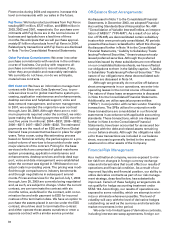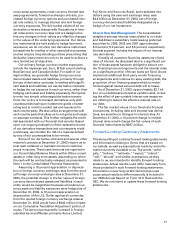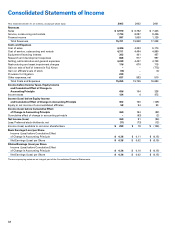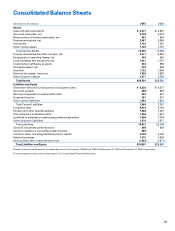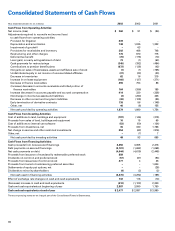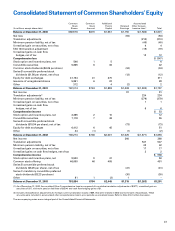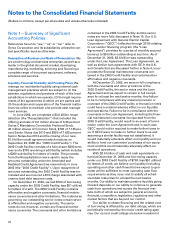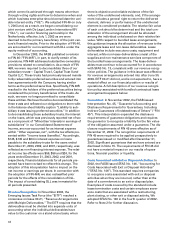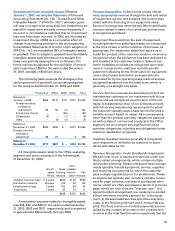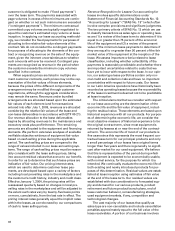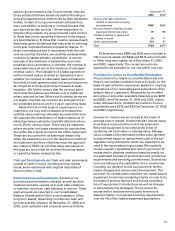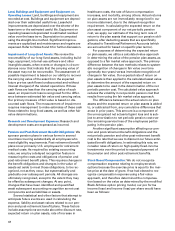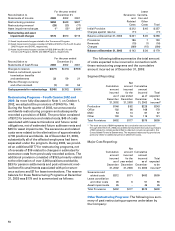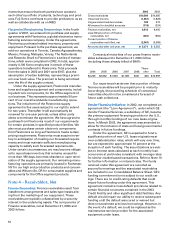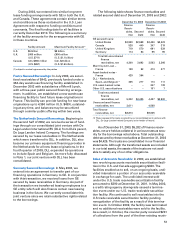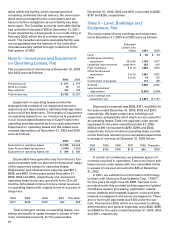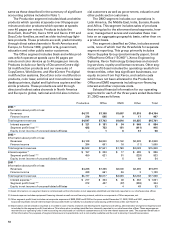Xerox 2003 Annual Report Download - page 48
Download and view the complete annual report
Please find page 48 of the 2003 Xerox annual report below. You can navigate through the pages in the report by either clicking on the pages listed below, or by using the keyword search tool below to find specific information within the annual report.
46
customer is obligated to make (“fixed payments”)
over the lease term. The payments associated with
page volumes in excess of the minimums are contin-
gent on whether or not such minimums are exceeded
(“contingent payments”). The minimum contractual
committed copy volumes are typically negotiated to
equal the customer’s estimated copy volume at lease
inception. In applying our lease accounting methodol-
ogy, we consider the fixed payments for purposes of
allocating to the relative fair value elements of the
contract. We do not consider the contingent payments
for purposes of allocating to the elements of the con-
tract or recognizing revenue on the sale of the equip-
ment, given the inherent uncertainties as to whether
such amounts will ever be received. Contingent pay-
ments are recognized as revenue in the period when
the customer exceeds the minimum copy volumes
specified in the contract.
When separate prices are listed in multiple ele-
ment customer contracts, such prices may not be rep-
resentative of the fair values of those elements,
because the prices of the different components of the
arrangement may be modified through customer
negotiations, although the aggregate consideration
may remain the same. Revenues under bundled
arrangements are allocated based upon the estimated
fair values of each element (and for transactions
entered into after July 1, 2003, revenues are allocated
considering the relative fair values of the lease and
non-lease deliverables in accordance with EITF 00-21).
Our revenue allocation to the lease deliverables
begins by allocating revenues to the maintenance and
executory costs plus profit thereon. The remaining
amounts are allocated to the equipment and financing
elements. We perform extensive analyses of available
verifiable objective evidence of equipment fair value
based on cash selling prices during the applicable
period. The cash selling prices are compared to the
range of values included in our lease accounting sys-
tems. The range of cash selling prices must be reason-
ably consistent with the lease selling prices, taking
into account residual values that accrue to our benefit,
in order for us to determine that such lease prices are
indicative of fair value. Our pricing interest rates,
which are used to determine customer lease pay-
ments, are developed based upon a variety of factors
including local prevailing rates in the marketplace and
the customer’s credit history, industry and credit class.
Effective January 1, 2004, the pricing rates will be
reassessed quarterly based on changes in local pre-
vailing rates in the marketplace and will be adjusted to
the extent such rates vary by twenty-five basis points
or more, cumulatively, from the last rate in effect. The
pricing interest rates generally equal the implicit rates
within the leases, as corroborated by our comparisons
of cash to lease selling prices.
Revenue Recognition for Leases: Our accounting for
leases involves specific determinations under
Statement of Financial Accounting Standards No. 13
“Accounting for Leases” (“SFAS No. 13”) which often
involve complex provisions and significant judgments.
The two primary criteria of SFAS No. 13 which we use
to classify transactions as sales-type or operating leas-
es are (1) a review of the lease term to determine if it is
equal to or greater than 75 percent of the economic
life of the equipment and (2) a review of the present
value of the minimum lease payments to determine if
they are equal to or greater than 90 percent of the fair
market value of the equipment at the inception of the
lease. We assess important criteria related to lease
classification, including whether collectibility of the
payments is reasonably predictable and whether there
are important uncertainties related to costs that we
have yet to incur with respect to the lease. In our opin-
ion, our sales-type lease portfolios contain only nor-
mal credit and collection risks and have no important
uncertainties with respect to future costs. Our leases
in our Latin America operations have historically been
recorded as operating leases because the recoverability
of the lease investment is deemed not to be predictable
at lease inception.
The critical elements that we consider with respect
to our lease accounting are the determination of the
economic life and the fair value of equipment, includ-
ing the residual value. Those elements are based upon
historical experience with all our products. For purpos-
es of determining the economic life, we consider the
most objective measure of historical experience to be
the original contract term, since most equipment is
returned by lessees at or near the end of the contract-
ed term. The economic life of most of our products is
five years since this represents the most frequent con-
tractual lease term for our principal products and only
a small percentage of our leases have original terms
longer than five years and there is generally no signifi-
cant after-market for our used equipment. We believe
that this is representative of the period during which
the equipment is expected to be economically usable,
with normal service, for the purpose for which it is
intended. We continually evaluate the economic life of
both existing and newly introduced products for pur-
poses of this determination. Residual values are estab-
lished at lease inception using estimates of fair value
at the end of the lease term. Our residual values are
established with due consideration to forecasted sup-
ply and demand for our various products, product
retirement and future product launch plans, end of
lease customer behavior, remanufacturing strategies,
used equipment markets, if any, competition and
technological changes.
The vast majority of our leases that qualify as
sales-type are non-cancelable and include cancellation
penalties approximately equal to the full value of the
lease receivables. A portion of our business involves


